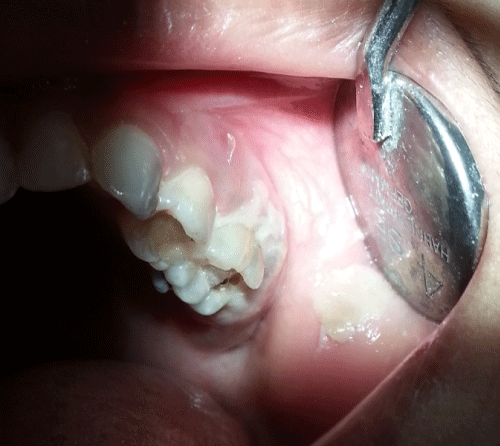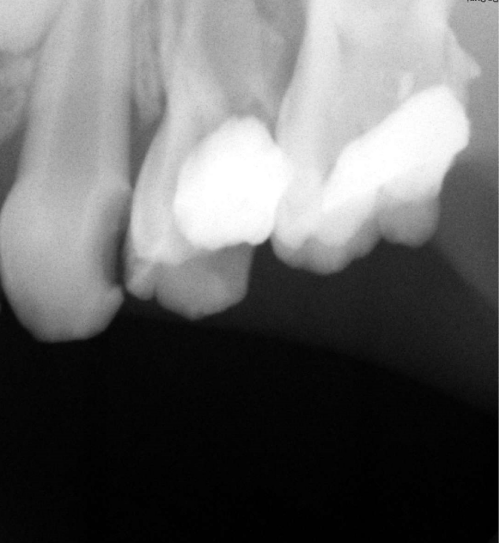
Case Report
Austin J Dent. 2014;1(2): 1007.
Allergic Reaction Associated with the use of Eugenol Containing Dental Cement in a Young Child
Deshpande A1, Verma S2 and Macwan C1*
1Department of Pedodontics and Preventive Dentistry, K. M. Shah Dental College and Hospital, India
2Dental Speciality Centre, India
*Corresponding author: Macwan Chirag, Department of Pedodontics and Preventive Dentistry, K. M. Shah Dental College and Hospital, Sumandeep Vidyapeeth, At & Po Pipariya, Waghodia, Vadodara, Gujarat- 391760, India
Received: July 02, 2014; Accepted: July 27, 2014; Published: July 30, 2014
Abstract
Allergic contact stomatitis is a rare disorder which may be easily overlooked by the clinician. Eugenol is one such material known to cause such reactions. We present a case report of a 6-year old girl in whom adverse local reaction to eugenol, contained within temporary restorative material which illustrates this problem. Based on the history and clinical features, we arrived at a diagnosis of allergic contact stomatitis and successfully treated the lesions. Treatment generally consists of eliminating the causal agent. Careful assessment of patients and of their dental and medical history is necessary to avoid such adverse reaction in the office.
Keywords: Dental material; Allergic reaction; Eugenol; Contact stomatitis; ZOE cement
Introduction
Allergic reactions associated to dental materials are not unknown [1]. Eugenol is widely used in dentistry in different forms and combinations. Eugenol has been widely used in dental products for many years. It has been incorporated into impression pastes, periodontal dressings, cements, filling materials, endodontic sealers, and dry socket dressings. Oil of cloves, or eugenol in its unrefined form, is mixed with zinc oxide to form zinc oxide-eugenol (ZOE), which exhibits a combination of physical and therapeutic properties making it useful as a provisional restorative material, base material, and root canal filling material [2]. The joint Food and Agriculture Organisation/WHO committee on food additives has permitted an acceptable daily intake of eugenol of 2.5 mg/kg body weight for humans [3]. It is considered non-carcinogenic and non-mutagenic and is generally recognised as safe by the Food and Drug Administration [4]. On the other hand, there are many studies about the cytotoxicity of eugenol [5,6]. The eugenol of ZOE cement can cause tissue effects, from low-grade local reactions to the rare, but serious, anaphylactic reaction. These reactions can be categorized into three types: direct tissue damage due to the nature of the medication; contact dermatitis/ stomatitis; and true allergic reaction [2,7]. However, there have been rare reports of hypersensitivity reaction to eugenol. In the present paper we have discussed a case of a young child in whom adverse allergic reaction was noticed due to ZOE cement, and this serves to remind colleagues of the need for care in its use.
Case Presentation
Six-year-old girl visited a private dental clinic with the chief complain of pain in maxillary left first and second primary molars (64, 65). No significant family and medical history was revealed. Intraoral examination revealed extensive disto-occlusion caries in 64 and 65. Radiographic examination revealed peri-radicular pathosis in 64 and 65, and these teeth were planned for multi-visit pulpectomy.
Under local anesthesia infiltration access opening and pulp extirpation were done. Root canal was irrigated with normal saline and closed dressing was given with form cresol cotton pellet. Access cavity was sealed with temporary restoration using Zinc Oxide Eugenol (ZOE) cement. Patient was recalled after two days for further treatment. Patient reported on the very next-day with complain of burning sensation and pain in the upper left back tooth region along with the history given by patient's guardian of itching in the same region after few hours of the treatment. Intraoral examination revealed allergic reaction "contact stomatitis" [8] caused by the ZOE cement on the gingiva and buccal mucosa (Figure 1). Intraoral periapical radiograph (IOPA) of 63, 64 and 65 region was taken that revealed that ZOE cement was in contact to soft tissue distal to the 65 (Figure 2). Patient's parent was explained about the unusual occurrence during the treatment and further management of the reaction. For confirmatory diagnosis of the lesion, "patch test" of zinc oxide powder and eugenol oil was planned for the patient. Parents were explained for the same, but they denied undergoing for patch testing for their child. Temporary restoration was removed, and normal saline irrigation was done to remove remnant of the ZOE cement. Glass Ionomer Cement (GIC) was used as a temporary restoration to avoid further insult to the tissue. The patient was kept under observation for a week. The lesion appeared to be healed after a week so pulpectomy was completed using Vitapex® (Calcium Hydroxide Paste with Iodoform) obturating material. Post obturatuion was done using GIC restorative material followed by stainless steel crown as a final restoration. No relapse or recurrence was observed during 3 months follow-up visit. Parents were also instructed for the future dental visits that they need to disclose that child is allergic to eugenol/ clove oil.
Figure 1: Intraoral examination revealed unusual allergic reaction on the gingiva and buccal mucosa caused by ZOE cement.
Figure 2: IOPA showing radio-opaque cement in contact with the soft tissue distally to the crown of 65 with.
Discussion
Eugenol was first isolated in 1929 and commercial production started in the USA in the 1940s [9]. Eugenol or oil of clove is an integral part of many essential oils. It is the main constituent of oil of carnation (80 %), oil of bay (60 %) and pimento oil (80 %). Eugenol is a pale yellow fluid with a strong smell of carnation and a burning taste [2]. Chisholm in 1873 described its mixture with zinc oxide to form polymerised eugenol cement. The end product of the setting reaction between zinc oxide and eugenol produces zinc eugenolate, which is not stable in the presence of water. This end product readily undergoes hydrolysis with the release of free eugenol that is initially rapid and then decreases exponentially, as all the surface eugenol is hydrolysed [10]. This released eugenol if contact the oral soft tissue can cause adverse allergic reaction in few individuals [2, 11-14].
The extent of oral soft tissue reaction associated with eugenol is dose dependent. At high concentration eugenol causes adverse effect on fibroblast and osteoblasts-like cells [15]. This causes localised necrosis and reduced healing. In lower concentration it causes localised hypersensitivity reactions to oral mucosa called "contact stomatitis" [2,8]. However, eugenol causes allergic contact dermatitis, possibly because it can react directly with proteins to form conjugates and reactive haptens [16].
These reactions can be either acute or chronic. Clinical presentations vary based on the nature of reaction, type of allergen site and duration of contact. In present case constant contact of ZOE cement caused localised reaction of soft tissue and buccal mucosa contacting the tooth. Amount of cement used was less hence the concentration of eugenol was lower so it caused localised contact stomatitis.
Diagnosing allergic contact stomatitis is primarily based on physical examination and medical history. When the symptoms are present the patient should be referred to a dermatologist for consultation. A patch test (contact delayed hypersensitivity allergy test) is a commonly used examination to determine the exact cause of an allergic contact dermatitis/stomatitis. According to the American Academy of Allergy, Asthma and Immunology, "patch testing is the gold standard for contact allergen identification" [17]. The patch test should be undertaken for the material used during procedure by a dermatologist. In present case parents were not whiling for such test so this test were not performed for the child.
Identification and elimination of the allergen that initiated the reaction is essential to treat the condition, as well as to prevent recurrences. Lesions respond well once the antigenic stimulus is eliminated. Antihistamines, topical anesthetics and topical corticosteroids are the commonly used pharmacological agents. Use of antihistamine suspensions in a swish and swallow method provide the advantage of both local and systemic action. In present case removal of the allergen was ample to manage the allergic reaction. GIC restoration was used for substituting the ZOE cement which was well tolerated by the patient.
Conclusion/ Learning Points
- Care should be taken to avoid tissue contact and manufacturer's instructions should be followed when eugenol containing ZOE cement is used.
- Other safer eugenol free temporary restorative cement should use to avoid such unusual occurrence.
- Any patient suspected of having an allergy to dental materials should be referred to a healthcare professional capable of performing and interpreting allergy tests prior to dental treatment.
References
- Wiltshire WA, Ferreira MR, Ligthelm AJ. Allergies to dental materials. See comment in PubMed Commons below Quintessence Int. 1996; 27: 513-520.
- Sarrami N, Pemberton MN, Thornhill MH, Theaker ED. Adverse reactions associated with the use of eugenol in dentistry. See comment in PubMed Commons below Br Dent J. 2002; 193: 257-259.
- FAO/WHO Expert Committee on Food Additives. Evaluation of certain food additives and contaminants. WHO Techl Rep Ser. 1982; 683: 60.
- Sarrami N, Pemberton MN, Thornhill MH, Theaker ED. Adverse reactions associated with the use of eugenol in dentistry. See comment in PubMed Commons below Br Dent J. 2002; 193: 257-259.
- Hume WR. Effect of eugenol on respiration and division in human pulp, mouse fibroblasts, and liver cells in vitro. See comment in PubMed Commons below J Dent Res. 1984; 63: 1262-1265.
- Wright SE, Baron DA, Heffner JE. Intravenous eugenol causes hemorrhagic lung edema in rats: proposed oxidant mechanisms. See comment in PubMed Commons below J Lab Clin Med. 1995; 125: 257-264.
- Karabucak B, Stoopler ET. Root canal treatment on a patient with zinc oxide allergy: a case report. See comment in PubMed Commons below Int Endod J. 2007; 40: 800-807.
- LeSueur BW, Yiannias JA. Contact stomatitis. See comment in PubMed Commons below Dermatol Clin. 2003; 21: 105-114, vii.
- Barceloux DG. Medical toxicology of natural substances: foods, fungi, medicinal herbs, plants and venomous animals. Wiley: Hoboken, NJ, USA. 2008.
- Anusavice K. Phillips' Science of Dental Materials. 11th ed. Saunders: USA. 2003.
- Tammannavar P, Pushpalatha C, Jain S, Sowmya SV. An unexpected positive hypersensitive reaction to eugenol. See comment in PubMed Commons below BMJ Case Rep. 2013; 2013.
- Grade AC, Martens BP. Chronic urticaria due to dental eugenol. See comment in PubMed Commons below Dermatologica. 1989; 178: 217-220.
- Bhalla M, Thami GP. Acute urticaria due to dental eugenol. See comment in PubMed Commons below Allergy. 2003; 58: 158.
- Koch G, Magnusson B, Nyquist G. Contact allergy to medicaments and materials used in dentistry. II. Sensitivity to eugenol and colophony. See comment in PubMed Commons below Odontol Revy. 1971; 22: 275-289.
- Alpar B, Günay H, Geurtsen W, Leyhausen G. Cytocompatibility of periodontal dressing materials in fibroblast and primary human osteoblast-like cultures. See comment in PubMed Commons below Clin Oral Investig. 1999; 3: 41-48.
- Rastogi SC, Heydorn S, Johansen JD, Basketter DA. Fragrance chemicals in domestic and occupational products. See comment in PubMed Commons below Contact Dermatitis. 2001; 45: 221-225.
- Bernstein IL, Li JT, Bernstein DI, Hamilton R, Spector SL, Tan R, et al. Allergy diagnostic testing: an updated practice parameter. See comment in PubMed Commons below Ann Allergy Asthma Immunol. 2008; 100: S1-148.

